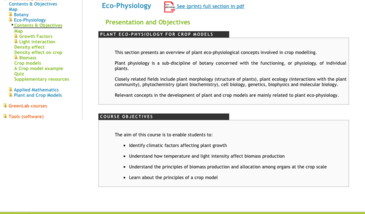En ligne depuis le 17/05/2015
0/5 (0)

Description
This section presents an overview of plant physiology concepts involved in crop modelling.
Thermal Time normalization - The thermal time normalization allows comparing plant growth on both organogenesis (organ numbering) and development (organ size) aspects.
Light interception: PAR, LAI and Beer-Lambert Law - Only part of the light energy is used in plant crops. A limited fraction of the light spectrum is absorbed by the leaves; this part is constrained by the upper leaf area and decreases in the canopy.
Photosynthesis. Light Use Efficiency - Photosynthesis process converts absorbed light energy to biomass with a ratio proportional to the Light Use Efficiency.
Density effect - At the individual plant level, density limits light absorption capabilities, and thus dynamically limits the biomass production.
Biomass common pool - Biomass produced by the source Organs (leaves) builds a common storage pool, to be share among all competing growing organs.
Organ competition - Sinks Organs growing compete for biomass allocation. They are sinks.
Process Bases Models - Process Based Models or Crop models aim to model and simulate the biomass production.
État
- Labellisé
Langues
- Anglais
Licence Creative Commons
- Partage des conditions à l'identique
- Pas d'utilisation commerciale
- Pas de modification
Types
- Grain numérique

